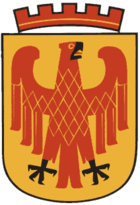Potsdam
(This article is about the German city of Potsdam. There is also Potsdam, New York in the United States of America.)
| Coat of Arms | |
|---|---|
 |
|
| Basic Information | |
| State: | Brandenburg |
| Area: | 187.28 km² |
| Population: | 145,002 (30 June 2004) |
| Population density: | 774 residents/km² |
| Elevation: | 35 m above sea level |
| Postal codes: | 14401-14482 (old: 15xx) |
| Telephone prefix: | 0331 |
| Latitude and Longitude: | 52° 23′ north, 13° 4′ east |
| License plate prefix: | P |
| Organisation: | 6 suburbs and 9 local authorities |
| Website: | www.potsdam.de |
| Politics | |
| Mayor: | Jann Jakobs (SPD) |
Potsdam [ˈpɔtsdam] (population 145,002 on 30 June 2004) is a city in eastern Germany, and the capital of the state of Brandenburg. It is situated on the Havel river, 26km south-west of Berlin, accessible by S-Bahn (Metro). It also has a series of interconnected lakes.
History
Potsdam was probably founded in the 10th century as a Slavic village called "Poztupimi", centred on a castle. It was first mentioned in 993, and by 1317 is mentioned as a small (by now German) town, gaining its town charter in 1345. In 1573 it was still a small market town (2000 inhabitants); the Thirty Years War (1618 - 1648) destroyed nearly half the town.
Potsdam's fortunes changed dramatically when it was chosen for the hunting residence of Frederick William I, elector of Brandenburg, in 1660. It also housed a Prussian barracks. The city was later also adopted as a residence of the Prussian royal family. The majestic buildings were mainly built during the reign of Frederick the Great. The Sanssouci Palace (in French: "without cares", by Georg Wenzeslaus von Knobelsdorff, 1744) is one of these buildings, famed for its formal gardens and Rococo interiors.

While Berlin was the official capital of Prussia and later of the German Empire, the court remained in nearby Potsdam, and many government officials also settled in Potsdam. The city lost this status as a second capital in 1918, when the World War I was over and the emperor Wilhelm II deposed.
At the beginning of the Third Reich a ceremonial handshake between Reichspresident Paul von Hindenburg and the new Chancellor Adolf Hitler took place on 21st March 1933 in Potsdam's Garnisonskirche (Garrison Church), symbolising a coalition of the military (Reichswehr) and Nazism.
Potsdam was severely damaged in bombing raids during World War II. The Cecilienhof palace was the scene of the Potsdam Conference from 17 July to 2 August 1945, as the victorious Allied leaders (Franklin D. Roosevelt followed by Harry S. Truman; Winston Churchill followed by Clement Attlee; and Stalin) met to decide the future of Germany.
Recent history
The government of the GDR endeavoured to erase the symbols of Prussian militarism. Many historic buildings, many of which were badly damaged, were torn down. Potsdam bordered on West Berlin and was, after the construction of the Berlin Wall, cut off from the neighbouring metropolis.
After the German reunification Potsdam became the capital of the newly re-established state of Brandenburg.
Politics
Potsdam has had a mayor (Bürgermeister) and city council since the fifteenth century. From 1809 the city council was elected, with a super-mayor (Oberbürgermeister) at its head. In the Third Reich the mayor was selected by the NSDAP and the city council dissolved; it was reconstituted in token form after the Second World War, but free elections did not take place until after reunification.
Today the city council is the central administrative organ of the city. The last local elections took place on 26th October 2003, with the next in 2008. From 1990 to 1999 the Chairman of the city council was known as the "Town President" (now simply "Chairman of the city council"). The mayor is directly elected. At the last mayoral elections of 22 September 2002 no candidate gained an overall majority, and a run-off election was conducted between Jann Jakobs (SPD) und Hans-Jürgen Scharfenberg (PDS), with Jann Jakobs gaining the narrowest of victories, with 50.1%.
Twinned cities
- Opole (Silesia) (Poland), since 1973
- Minsk (Belarus)
- Bobigny (France), since 1974
- Jyväskylä (Finland), since 1985
- Bonn (Northrhine-Westphalia), since1988
- Perugia (Italy), since 1990
- Sioux Falls, South Dakota (USA), since 1990
- Lucerne (Switzerland), since 2002
Education and research
Potsdam is a university town. The University of Potsdam was founded in 1991 as a university of the Land Brandenburg. Its predecessor was the Brandenburgische Landeshochschule Karl Liebknecht, a College of Education founded in 1948 which was one of the GDR's most important colleges.
In addition there is a College of Film and Television, founded in 1954 in Babelsberg, the foremost centre of the German film industry since its birth. There are also several research foundations, including a Fraunhofer Institute for Applied Polymer Research and a Max Planck Institute for Gravitational Physics (Albert-Einstein-Institute).
Sights in Potsdam

- Sanssouci Palace, former palace of the Prussian royal and German imperial families
- Orangery Palace, former palace for foreign royal guests
- Neues Palais ("New Palace"), an additional palace in Sanssouci Park, built in 1769
- Charlottenhof, another palace in Sanssouci Park, by Karl Friedrich Schinkel (1826)
- New Garden with two smaller palaces, one of them Cecilienhof, where the Potsdam Conference was held
- Old Town with the Brandenburg Gate (1770, not to be confused with the Brandenburg Gate in Berlin), St. Nikolai church (1850) and town hall (1753)
- Babelsberg, a quarter east of the centre, housing the UFA film studios
- Einstein Tower, Erich Mendelsohn architect, 1920-24
- Alexandrovka, a small enclave of Russian architecture due to 17th-century Russian immigrants
